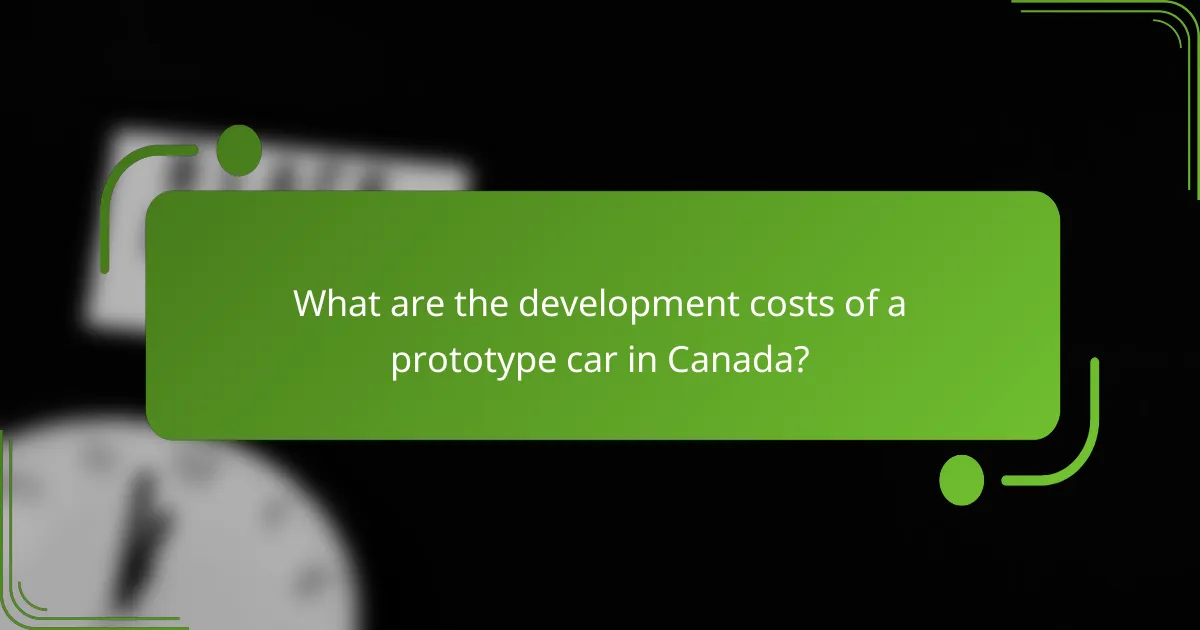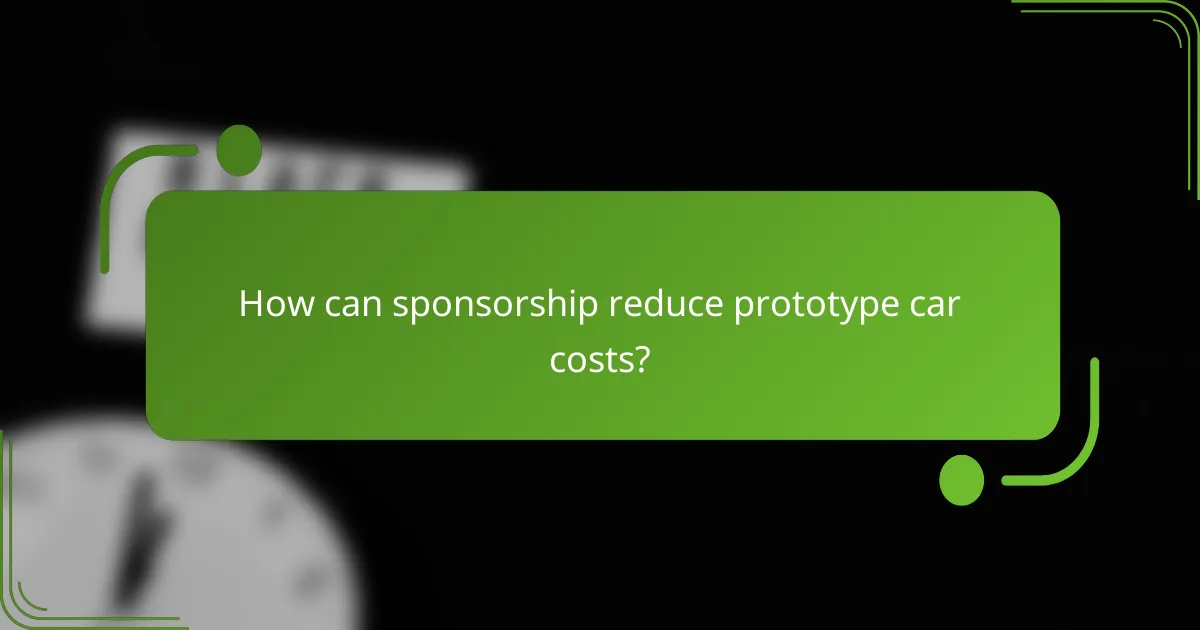The development of a prototype car involves substantial costs that can range from several hundred thousand to several million Canadian dollars, influenced by factors such as materials and technology. To mitigate these expenses, sponsorship plays a vital role, offering financial support and resources while enhancing brand visibility for partnering companies. Comprehensive testing phases, including design validation and safety assessments, are essential to ensure the vehicle meets necessary standards before entering full-scale production.

What are the development costs of a prototype car in Canada?
The development costs of a prototype car in Canada can vary significantly based on various factors, including materials, labor, technology, and testing requirements. Generally, these costs can range from several hundred thousand to several million Canadian dollars, depending on the complexity and specifications of the vehicle.
Material costs
Material costs for a prototype car typically include metals, plastics, composites, and other components necessary for construction. Depending on the materials chosen, these costs can range from tens of thousands to several hundred thousand Canadian dollars. High-performance materials may increase expenses but can enhance the vehicle’s capabilities.
When selecting materials, consider the balance between weight, strength, and cost. For instance, carbon fiber is lightweight but expensive, while steel is more affordable but heavier.
Labor costs
Labor costs encompass the wages of engineers, designers, and technicians involved in the prototype’s development. These costs can vary widely, often falling between 20% to 40% of the total development budget. Skilled labor is essential for quality design and engineering, which can significantly impact the overall success of the project.
To manage labor costs effectively, consider outsourcing certain tasks or utilizing contract workers for specialized skills. This approach can provide flexibility and potentially reduce expenses.
Technology expenses
Technology expenses include software for design, simulation, and testing, as well as hardware for prototyping and manufacturing. These costs can range from tens of thousands to over a hundred thousand Canadian dollars, depending on the tools and technologies utilized. Advanced simulation software can help optimize designs and reduce physical testing needs.
Investing in the right technology early on can save costs in the long run by minimizing errors and improving efficiency throughout the development process.
Regulatory fees
Regulatory fees are associated with compliance testing and certification required by Canadian automotive standards. These fees can vary based on the vehicle type and intended use, often costing thousands of Canadian dollars. Ensuring compliance with safety and environmental regulations is crucial to avoid costly delays or redesigns.
Familiarize yourself with the specific regulations applicable to your prototype to budget adequately for these fees and streamline the approval process.
Testing costs
Testing costs involve expenses related to performance, safety, and durability evaluations of the prototype. These costs can range from tens of thousands to several hundred thousand Canadian dollars, depending on the extent of testing required. Comprehensive testing is essential to validate the prototype’s design and ensure it meets safety standards.
To optimize testing costs, prioritize critical tests that align with your project goals and consider using simulation tools to reduce the number of physical tests needed. This strategy can help manage expenses while still achieving reliable results.

How can sponsorship reduce prototype car costs?
Sponsorship can significantly lower the costs associated with developing prototype cars by providing financial support and resources. Companies and organizations often seek partnerships to enhance their brand visibility while helping innovators offset expenses related to research, materials, and testing.
Corporate sponsorship opportunities
Corporate sponsorship opportunities are available from various industries, including technology, energy, and automotive sectors. Companies may offer funding or in-kind contributions, such as materials or expertise, in exchange for branding on the prototype or promotional opportunities.
To attract corporate sponsors, clearly outline the benefits they will receive, such as exposure at events or media coverage. Building a compelling pitch that highlights the innovation and market potential of the prototype can enhance sponsorship prospects.
Government grants and incentives
Government grants and incentives can provide essential funding for prototype car development. Many governments offer financial assistance to promote innovation, sustainability, and technological advancement in the automotive sector.
Research local and national programs that support automotive innovation, as these can vary widely. For instance, in the European Union, various Horizon programs may offer grants, while in the United States, the Department of Energy provides funding for clean energy vehicle projects.
Partnerships with automotive brands
Forming partnerships with established automotive brands can lead to shared resources and reduced costs for prototype development. These brands may be interested in collaborating on new technologies or concepts that align with their strategic goals.
To initiate partnerships, approach automotive companies with a clear proposal that outlines mutual benefits. Consider showcasing how the prototype aligns with their innovation strategies or sustainability goals, which can make the partnership more appealing.

What are the key testing phases for prototype cars?
The key testing phases for prototype cars include initial design validation, performance testing, safety testing, and durability testing. Each phase is crucial for ensuring the vehicle meets design specifications and regulatory standards before full-scale production.
Initial design validation
Initial design validation involves assessing the prototype’s design against its intended specifications. This phase typically includes computer simulations and early physical tests to identify any design flaws or areas for improvement.
During this stage, engineers often use tools like CAD software to refine the design and may conduct wind tunnel tests to evaluate aerodynamics. It’s essential to address any issues early to avoid costly changes later in the development process.
Performance testing
Performance testing evaluates how well the prototype performs under various conditions. This includes acceleration, braking, handling, and fuel efficiency assessments, often conducted on closed tracks or controlled environments.
Key metrics to monitor during performance testing include lap times, top speed, and fuel consumption. These tests help determine if the vehicle meets performance benchmarks and can guide adjustments to enhance driving dynamics.
Safety testing
Safety testing is critical for ensuring that the prototype meets safety regulations and protects occupants in the event of a collision. This phase typically involves crash tests, where the vehicle is subjected to various impact scenarios.
Common tests include frontal, side, and rollover crash simulations, which help assess the effectiveness of safety features like airbags and crumple zones. Compliance with standards such as Euro NCAP or NHTSA ratings is essential for market acceptance.
Durability testing
Durability testing assesses the prototype’s longevity and reliability over time. This phase often includes prolonged driving under extreme conditions to simulate years of use in a shorter timeframe.
Tests may involve driving on rough terrain, extreme temperatures, and varying loads to evaluate how components withstand wear and tear. Identifying potential failures early can save significant costs and enhance customer satisfaction in the long run.

What criteria should be considered for prototype car sponsorship?
When seeking sponsorship for a prototype car, it’s essential to evaluate criteria such as brand alignment, target audience engagement, and return on investment potential. These factors help ensure that the partnership is mutually beneficial and effectively supports the development and promotion of the prototype.
Brand alignment
Brand alignment refers to how well the sponsor’s values, image, and goals match those of the prototype car project. A strong alignment can enhance credibility and create a cohesive marketing message. For instance, a tech company sponsoring an electric vehicle prototype can leverage innovation and sustainability themes that resonate with both brands.
To assess brand alignment, consider conducting a brand audit. Identify the core values of both the sponsor and the project, and look for common ground. This alignment can lead to more effective marketing campaigns and a stronger partnership.
Target audience engagement
Engaging the target audience is crucial for a successful sponsorship. The sponsor should have access to a demographic that is interested in the prototype car’s features, such as performance, technology, or environmental impact. Understanding the audience can help tailor marketing efforts and create compelling narratives around the prototype.
Utilize market research to identify the demographics of both the prototype’s potential users and the sponsor’s customer base. This information can guide promotional strategies, ensuring that both parties benefit from increased visibility and engagement.
Return on investment potential
Return on investment (ROI) potential is a critical factor in evaluating sponsorship opportunities. Sponsors want to ensure that their financial contributions will yield measurable benefits, such as increased sales, brand awareness, or market share. Establishing clear metrics for success is essential.
Consider setting specific goals for the sponsorship, such as a target percentage increase in brand recognition or sales figures within a defined period. Regularly review performance against these metrics to assess the effectiveness of the sponsorship and make necessary adjustments to maximize ROI.

How does location impact prototype car development in Canada?
Location significantly influences prototype car development in Canada by affecting access to resources, testing opportunities, and regulatory environments. Factors such as proximity to automotive hubs and testing facilities can streamline the development process and reduce costs.
Access to automotive hubs
Canada is home to several key automotive hubs, particularly in Ontario and Quebec, where numerous manufacturers and suppliers are concentrated. Being near these hubs can facilitate partnerships, access to skilled labor, and sourcing of materials, which can lower development costs and improve innovation.
For instance, companies in the Greater Toronto Area benefit from a rich ecosystem of automotive expertise, making it easier to collaborate on prototype development. This access can lead to faster iterations and reduced time-to-market for new vehicles.
Proximity to testing facilities
Having prototype cars tested in close proximity to development sites is crucial for efficient iteration. Canada boasts several advanced testing facilities, including those in Ontario and Alberta, which offer diverse environments for evaluating vehicle performance.
Utilizing local testing facilities can significantly reduce transportation costs and time. For example, testing a vehicle in varying climates and terrains can provide valuable data that informs design adjustments, ultimately enhancing the vehicle’s performance.
Local regulations and incentives
Local regulations in Canada can impact prototype car development by dictating safety standards and environmental requirements. Understanding these regulations is essential for compliance and can influence design choices early in the development process.
Additionally, various provincial and federal incentives exist to support automotive innovation, such as grants for research and development. Companies that leverage these incentives can offset some of their development costs, making it financially advantageous to operate in specific regions.
